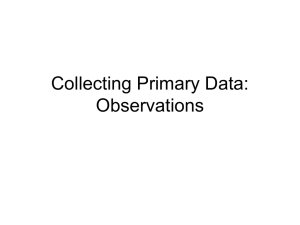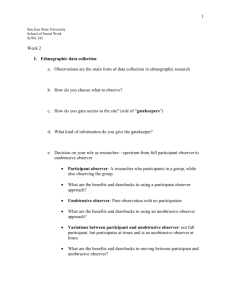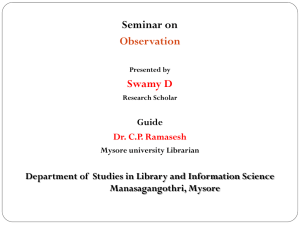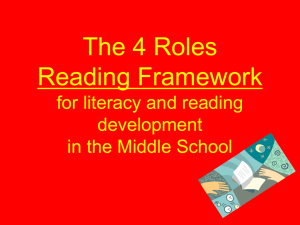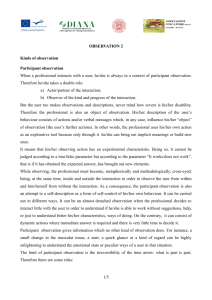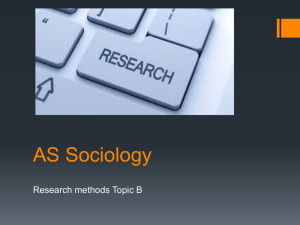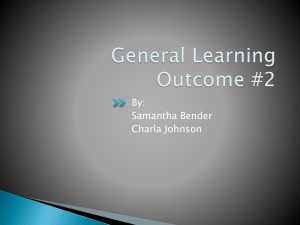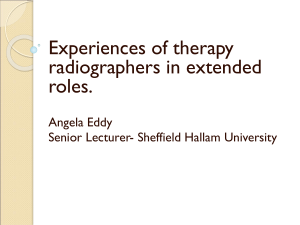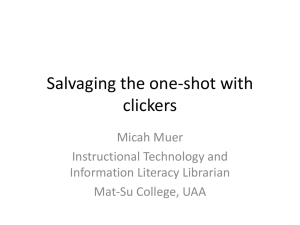Observation
advertisement
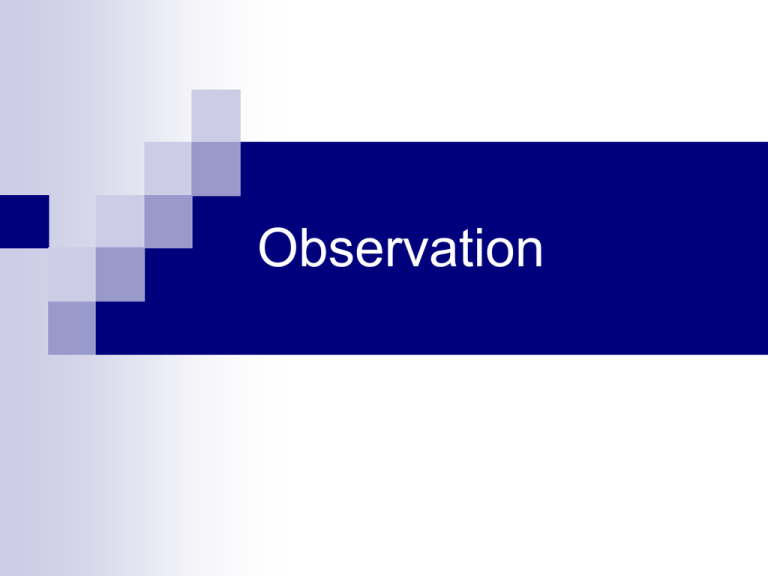
Observation What is Observation? Observation is a systematic data collection approach. Researchers use all of their senses to examine people in natural settings or naturally occurring situations. Observation of a field setting often involves: prolonged engagement in a setting or social situation clearly expressed, self-conscious notations of how observing is done methodical and tactical improvisation in order to develop a full understanding of the setting of interest imparting attention in ways that is in some sense 'standardized' recording one's observations Participant Observation Participant observation "combines participation in the lives of the people being studied with maintenance of a professional distance that allows adequate observation and recording of data" (Fetterman, 1998) Participant observation underscores the person's role as participant in the social setting he or she observes. The range of roles one may play as a participant observer have been describe by Gold (1958). Non-Participant Observation Non-participant observation is observation with no or limited interaction with the people one observes. Some observational data can be collected unobtrusively using erosion and accretion measures. Researchers who study how people communicate often want to examine the details of how people talk and behave together. In special cases, a recording device may be used.. Non-participant observation provides limited insight into the meaning of the social context being studied and is often combined with participant observation. Raymond Gold’s Typology (1958) The complete participant - takes an insider role, is fully part of the setting and often observes covertly. The participant as observer - the researcher gains access to a setting by virtue of having a natural and non-research reason for being part of the setting. As observers, they are part of the group being studied. This approach may be common in health care settings where members of the health care team are interested in observing operations in order to understand and improve care processes. The observer as participant - In this role, the researcher or observer has only minimal involvement in the social setting being studied. There is some connection to the setting but the observer is not naturally and normally part of the social setting. The complete observer - the researcher does not take part in the social setting at all. An example of complete observation might be watching children play from behind a two-way mirror. Fieldnotes, Jotted Notes and Protocols Observers often use multiple methods to gather data. One primary approach involves writing fieldnotes. Researchers may want to create and use an observational protocol (template) to guide observations. Theories and concepts can be used in constructing protocols and can result in focused data collection However, protocols or templates can deflect attention from unnamed and unanticipated categories that may be important to understanding a phenomenon and a setting Using Protocols Creswell (1998) recommends use of a “protocol” when collecting data to organize information and help keep research on track i.e. an interview schedule, a moderator’s guide or an observational protocol Jotted Notes Used for unobtrusive observation To record main observations, snippets of conversation, etc. Written by hand on scrap of paper, napkin, notebook. As soon as possible after observation ends, detailed field notes are written, using jotted notes and memory as a guide. Steps Select a site to be observed At the site, identify who or what to observe Determine what your role as observer will be Design an observational protocol as a method for recording notes in the field Record aspects such as the physical setting, particular events and activities, and your own reactions Withdraw from the site and as soon as possible, write a detailed description of your experience Guidelines for Note-taking Don’t rely on memory alone If complete field notes not feasible, use jotted notes and then write field notes Take notes in stages Record everything possible

